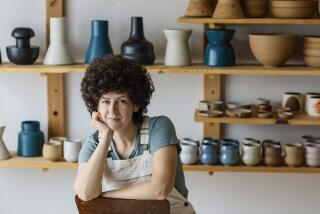Give ceramics a long shelf life
- Share via
A guest kind enough to volunteer for kitchen duty at my house is apt to be confronted by a variety of ceramic objects. These include mixed pieces of English bone china dinnerware, a couple of to-die-for Deco pitchers and nostalgia-laden Gallic hand-painted cafe-au-lait bowls of the Europe-on-$5-a-day era. Also in the inventory: an egg cup shaped like a shoe, a chipped butter dish with a Guernsey cow on the lid, and an “I Love My Mommy” mug.
Most of us, I suspect, have a similarly eclectic mix of useful and decorative ceramics, any of which can acquire a sentimental worth outweighing actual value. In short, we all cherish precious but fragile objects requiring care and, occasionally, repair.
Ceramics come in many forms, from rugged earthenware to translucent porcelain. The difference depends on the clay used, the temperature at which it was fired and the glaze, if any. The key thing to grasp is that ceramics baked at lower temperatures will be porous unless glazed, while porcelain and stoneware, fired at very high temperatures, are virtually nonporous but tend to be brittle. Porousness and brittleness also are influenced by glazing.
Unglazed pottery, as well as cracked or repaired ceramics, should never be immersed in water because they will absorb the water and become discolored. No valuable ceramic should be entrusted to a dishwashing machine. Its tools of destruction include detergent with abrasives that can dull and scratch, while the heat of drying can wreak havoc. Gold trim won’t survive many encounters, and the same goes for the decal decorations on that rare Elvis ashtray.
The good china taken out for special occasions can be washed safely by hand in warm water using mild detergent. When it comes to display pieces, though, these are best kept out of water.
Porcelain dishes that have never undergone repairs and other items fired at high temperatures can be cleaned safely with a soft damp cloth. For repaired ceramics, including figurines, the safest way to clean is gentle dusting with a lint-free cloth, tackling hard-to-reach spots with a Q-tip or brush.
Valuable objects should be handled one at a time, either with clean, dry hands or cotton gloves. Always remove rings, because these can cause scratches.
The less any valuable piece is handled, the better. Ideally, ceramics should be displayed behind glass, as this helps keep them clean. Objects should not be exposed to direct sunlight, and because we live in an earthquake zone, it’s wise to have each shelf fitted with a low safety rail.
To store ceramics, wrap items individually in acid-free tissue and pack them in cartons lined with foam or packing chips. Pack lids separately and fill empty space with more packing chips.
It’s OK to use bubble wrap for a move but not for long-term storage because it tends to attract and retain moisture. Never use newspaper as wrapping material because it can cause discoloration. Finally, be sure to store cartons in an area not subject to extremes in temperature.
If a precious dessert plate is broken, repair it yourself only if you are prepared to see it lose all value. Commonly used glues may hold a dish together, but they tend to darken and change color. If you hope to see the object looking anything like its old self, gather the pieces, wrap them individually in acid-proof tissue, and take them to a professional restorer, such as Golberg Restoration Co. in L.A., (310) 652-0735; Foster Art Restoration in Costa Mesa, (949) 645-9953; and Just Enterprises Art & Antique Restorations in Ventura, (805) 644-5837.
As anyone who has visited an archeological museum can attest, the work done by pottery conservators is often astonishing, but it can be expensive.
Christopher Finch is a former curator of the Walker Art Center in Minneapolis and a former editor of Design Quarterly.
More to Read
Eat your way across L.A.
Get our weekly Tasting Notes newsletter for reviews, news and more.
You may occasionally receive promotional content from the Los Angeles Times.










